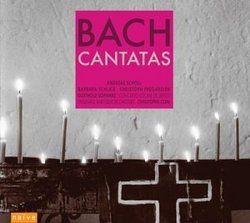Light, Airy, Charming, Sensitive Playing and Singing
J Scott Morrison | Middlebury VT, USA | 02/02/2004
(5 out of 5 stars)
"The three Bach cantatas in this reissue (originally on Auvidis Astrée in 1993) are tied together by the presence in all three of the violoncello piccolo, an instrument briefly popular during the early 18th century and specifically chosen by Bach for only a few works. The instrument was smaller than the ordinary cello and had a fifth string on e''' a fifth above the cello's a string. The noted cellist, Christophe Coin (known to many as cellist of the original instrument string quartet Quatuor Mosaïques) plays the extensive violoncello piccolo part and conducts the Ensemble Baroque de Limoges and the Concerto Vocale of Leipzig. His wonderful soloists are Barbara Schlick, soprano, and Andreas Scholl, alto (both at the beginning of their illustrious careers), Christoph Prégardien, tenor, and bass Gotthold Schwarz.Cantata BWV 180, 'Schmücke dich, o liebe Seele' ('Deck yourself, my soul, with gladness') is a choral cantata, with three verses of a hymn by Johan Frank. It depicts the wedding of the king's son from Matthew 22. There is a lively tenor aria, sung very well by Prégadien, followed by a soprano recitative and aria by the soprano, 'Mein Herz fühlt in sich Furcht und Freude,' that contains a gorgeous violoncello piccolo countermelody in sixteenth notes, almost a perpetuo moto; it is played with spring and grace by Coin. Schlick is wonderful here. The choir, in this and the rest of the disc, is a small group that sing lightly and with a bell-like tone that is quite charming. This cantata is a joyful one.BWV 49, 'Ich geh und suche mit Verlangen' ('I go and seek with longing') is for bass, soprano and orchestra; it is one of the few cantatas with no chorus. It begins with a Sinfonia that is taken from the third movement of Bach's Harpsichord Concerto in E major (BWV 1053) arranged to eliminate the harpsichord soloist. [He had done the same thing with the first two movements of this concerto several weeks earlier for Cantata BWV 169.] The text of the cantata is, like that of BWV 180, from Matthew 22, the parable of the wedding supper. It is in the form of a dialog between the bass and soprano, and is possibly the earliest of Bach's dialog cantatas. (It dates from 1726.) The opening bass aria has an organ part that is independent of the continuo; it plays a theme and variations throughout the length of the aria, and indeed the aria is actually a duet between basso and organ. Next follows a dialog between bass and soprano (the Bride and Bridegroom). Then the soprano as the non-blushing bride sings an aria, 'Ich bin herrlich, ich bin schön' ('I am splendid, I am beautiful') accompanied by oboe d'amore and violoncello piccolo who imitate and elaborate on her melodic line. It ends with a duet between the Bride and Bridegroom, with soprano singing the chorale tune while the bass elaborates on the theme of their happiness. BWV 115, 'Mache dich, mein Geist, bereit' ('Prepare yourself, o my spirit') is notable in this recording for the unearthly beauty of the alto solo, 'Ach, schläfrige Seele, wie? ruhest du noch?' ('Ah, slumbering soul, are you still at rest?') sung here by one of the greatest countertenors now singing, Andreas Scholl, then at the very beginning of his career. It alone is worth the price of this CD. This 9-minute aria has elaborate accompanimental figures from oboe d'amore while the alto sings of the slumbering soul. Parts of it remind me of 'Erbarme dich' from the St. Matthew Passion. Gorgeous. The soprano aria that follows, 'Bete aber auch dabei mitten in dem Wachen!' ('But pray, too, pray and be vigilant') returns again and again to the words 'Bete' and 'Bitte' ('Pray' and 'Plead') with a memorable turn of melody. There is an ingenious and lovely recurring countermelody on flute and violoncello piccolo. It ends with a serene chorale, 'Drum so lasst uns immerdar' ('Since fear, affliction and danger are ever approaching, let us evermore watch, implore and pray'). A word about the recording. It was made in small German church that nonetheless had a quite spacious acoustic that is caught very nicely here. The organ, made by Silbermann in 1747, is tuned to A=460, so the organist, Willem Jansen, had to transpose down down a whole tone (hats off to him for that!) in order to play with the original instruments ensemble. Recommended, even over corresponding recordings by Rilling and Koopman. TT=70:03Scott Morrison"
I agree with Mr. Morrison
G. Metcalf | United States | 03/16/2006
(5 out of 5 stars)
"I wrote this short review to voice my agreement with Mr. Morrison who has already written a lengthy and considered review of this recording. Personally I like the more natural balance here compared to some other interpreters of Bach's cantatas who sometimes put the vocal soloists to far forward in the mix. This is an excellent CD."


 Track Listings (19) - Disc #1
Track Listings (19) - Disc #1